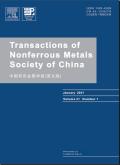溶解氧浓度对纯锌和锌-铜合金腐蚀行为的影响
IF 4.7
1区 材料科学
Q1 METALLURGY & METALLURGICAL ENGINEERING
Transactions of Nonferrous Metals Society of China
Pub Date : 2025-04-01
DOI:10.1016/S1003-6326(24)66746-4
引用次数: 0
摘要
为了研究生理液体环境中氧含量对生物医用锌基合金腐蚀行为的影响,利用体外供氧设备建立了不同溶解氧的体外模拟体液环境。采用扫描电镜、能量色散光谱、傅里叶变换红外光谱和电化学分析等方法研究了溶解氧浓度对纯Zn和Zn−Cu合金腐蚀行为的影响。由于吸氧腐蚀,溶解氧浓度的增加使溶液的pH值升高,促进腐蚀产物层的积累。与没有额外供氧的环境相比,连续供氧条件下试样的腐蚀速率提高了一个数量级。由于Zn−Cu合金具有微电偶腐蚀,在不同溶解氧条件下,其腐蚀速率约为纯锌的1.5倍。本文章由计算机程序翻译,如有差异,请以英文原文为准。
Effects of dissolved oxygen concentrations in Hanks’ solution on corrosion behavior of pure zinc and zinc−copper alloys
To investigate the influence of oxygen content in a physiological liquid environment on the corrosion behavior of biomedical zinc-based alloys, a simulated bodily fluid environment with varying dissolved oxygen was established in vitro using external oxygen supply equipment. The influence of dissolved oxygen concentration on the corrosion behavior of pure Zn and Zn−Cu alloys was studied with scanning electron microscopy, energy dispersive spectroscopy, Fourier transform infrared spectrometry, and electrochemical analysis. Due to oxygen absorption corrosion, the increase in dissolved oxygen concentration increases the pH value of the solution and promotes the accumulation of corrosion product layer. Compared with the environment without additional oxygen supply, the corrosion rate of the sample under the continuous oxygen supply condition is increased by one order of magnitude. Because the Zn−Cu alloy has micro-galvanic corrosion, its corrosion rate is about 1.5 times that of pure zinc under different dissolved oxygen conditions.
求助全文
通过发布文献求助,成功后即可免费获取论文全文。
去求助
来源期刊
CiteScore
7.40
自引率
17.80%
发文量
8456
审稿时长
3.6 months
期刊介绍:
The Transactions of Nonferrous Metals Society of China (Trans. Nonferrous Met. Soc. China), founded in 1991 and sponsored by The Nonferrous Metals Society of China, is published monthly now and mainly contains reports of original research which reflect the new progresses in the field of nonferrous metals science and technology, including mineral processing, extraction metallurgy, metallic materials and heat treatments, metal working, physical metallurgy, powder metallurgy, with the emphasis on fundamental science. It is the unique preeminent publication in English for scientists, engineers, under/post-graduates on the field of nonferrous metals industry. This journal is covered by many famous abstract/index systems and databases such as SCI Expanded, Ei Compendex Plus, INSPEC, CA, METADEX, AJ and JICST.

 求助内容:
求助内容: 应助结果提醒方式:
应助结果提醒方式:


